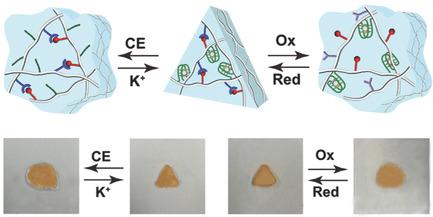当前位置:
X-MOL 学术
›
Adv. Funct. Mater.
›
论文详情
Our official English website, www.x-mol.net, welcomes your
feedback! (Note: you will need to create a separate account there.)
Stimuli‐Responsive Donor–Acceptor and DNA‐Crosslinked Hydrogels: Application as Shape‐Memory and Self‐Healing Materials
Advanced Functional Materials ( IF 18.5 ) Pub Date : 2018-07-10 , DOI: 10.1002/adfm.201803111 Chen Wang 1 , Michael Fadeev 1 , Margarita Vázquez-González 1 , Itamar Willner 1
Advanced Functional Materials ( IF 18.5 ) Pub Date : 2018-07-10 , DOI: 10.1002/adfm.201803111 Chen Wang 1 , Michael Fadeev 1 , Margarita Vázquez-González 1 , Itamar Willner 1
Affiliation

|
Carboxymethyl cellulose (CMC) chains are functionalized with self‐complementary nucleic acid tethers and electron donor or electron acceptor functionalities. The polymer chains crosslinked by the self‐complementary duplex nucleic acids and the donor–acceptor complexes as bridging units, yield a stiff stimuli‐responsive hydrogel. Upon the oxidation of the electron donor units, the donor–acceptor bridging units are separated, leading to a hydrogel of lower stiffness. By the cyclic oxidation and reduction of the donor units, the hydrogel is reversibly transformed across low and high stiffness states. The controlled stiffness properties of the hydrogel are used to develop shape‐memory hydrogels. In addition, CMC hydrogels crosslinked by donor–acceptor complexes and K+‐stabilized G‐quadruplexes reveal stimuli‐responsive properties that exhibit dually triggered stiffness functions. While the hydrogel bridged by the two crosslinking motifs reveals high stiffness, the redox‐stimulated separation of the donor–acceptor complexes or the crown‐ether‐stimulated separation of the G‐quadruplex bridges yields two alternative hydrogels exhibiting low stiffness states. The control over the stiffness properties of the dually triggered hydrogel is used to develop shape‐memory hydrogels, where the donor–acceptor units or G‐quadruplex bridges act as “memories”, and to develop triggered self‐healing process of the hydrogel.
中文翻译:

刺激响应的供体-受体和DNA交联水凝胶:用作形状记忆和自愈材料
羧甲基纤维素(CMC)链通过自身互补的核酸束缚带和电子供体或电子受体功能进行功能化。聚合物链通过自身互补的双链核酸和供体-受体复合物作为桥联单元交联,产生了刚性的刺激响应水凝胶。电子供体单元被氧化后,供体-受体桥联单元被分离,导致水凝胶的刚度降低。通过供体单元的循环氧化和还原,水凝胶在低和高刚度状态下可逆转化。水凝胶的受控刚度特性可用于开发形状记忆水凝胶。此外,CMC水凝胶通过供体-受体复合物和K +交联稳定的G四联体显示出具有双重触发刚度功能的刺激响应特性。由两个交联基元桥接的水凝胶显示出高的刚度,而供体-受体复合物的氧化还原刺激分离或G-四链体桥的冠醚-刺激的分离产生了两种显示出低刚度状态的替代水凝胶。对双重触发水凝胶的刚度特性的控制用于开发形状记忆水凝胶,其中供体-受体单元或G-四链桥充当“记忆”,并开发触发的水凝胶自愈过程。
更新日期:2018-07-10
中文翻译:

刺激响应的供体-受体和DNA交联水凝胶:用作形状记忆和自愈材料
羧甲基纤维素(CMC)链通过自身互补的核酸束缚带和电子供体或电子受体功能进行功能化。聚合物链通过自身互补的双链核酸和供体-受体复合物作为桥联单元交联,产生了刚性的刺激响应水凝胶。电子供体单元被氧化后,供体-受体桥联单元被分离,导致水凝胶的刚度降低。通过供体单元的循环氧化和还原,水凝胶在低和高刚度状态下可逆转化。水凝胶的受控刚度特性可用于开发形状记忆水凝胶。此外,CMC水凝胶通过供体-受体复合物和K +交联稳定的G四联体显示出具有双重触发刚度功能的刺激响应特性。由两个交联基元桥接的水凝胶显示出高的刚度,而供体-受体复合物的氧化还原刺激分离或G-四链体桥的冠醚-刺激的分离产生了两种显示出低刚度状态的替代水凝胶。对双重触发水凝胶的刚度特性的控制用于开发形状记忆水凝胶,其中供体-受体单元或G-四链桥充当“记忆”,并开发触发的水凝胶自愈过程。











































 京公网安备 11010802027423号
京公网安备 11010802027423号